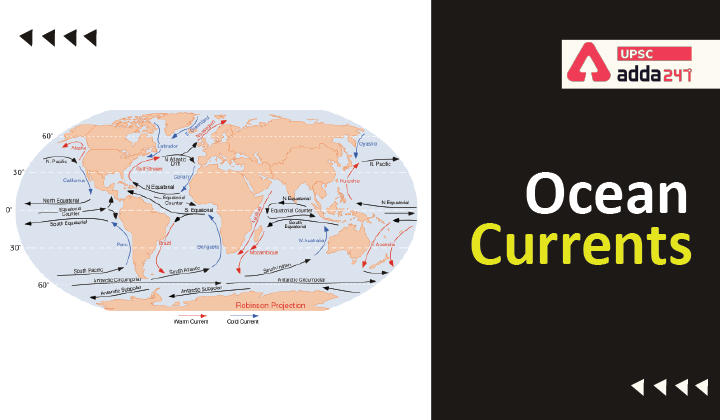Table of Contents
Ocean Currents
In the last article, we have discussed about the basics of ocean currents and the list of cold currents of the world. In this article, we will discuss some of the topics associated with ocean currents, including a list of ward ocean currents of the world.
In the last article, we have discussed that ocean current is divided in two categories, on the basis of temperature. While we discussed in detail the cold current in the last article, in this article, we will discuss about the warm currents.
Warm ocean current
- Warm currents travel from low latitudes to high latitudes and thus bring warm water into cold water areas.
- These currents are usually found on the east coast of continents in the low and middle latitudes (true in both hemispheres).
- In the northern hemisphere, however, they are found on the west coasts of continents in high latitudes.
Ocean currents of the world: Features
- Generally, currents move in the clockwise direction in the northern hemisphere, and in the anti-clockwise direction in the southern hemisphere.
- Exception: Northern part of the Indian Ocean is quite an aberration to the above stated fact as the currents in this region changes its direction in response to the seasonal change in the direction of monsoon winds.
- The cold currents move towards warm seas and vice versa.
- The coasts too play a role in influencing the direction and speed of the ocean currents.

Ocean currents map: Effects
Ocean currents have a number of direct and indirect effects on nature.
- Formation of a desert: West coasts of the continents in tropical and subtropical latitudes (except close to the equator) are bordered by cool waters. Due to this reason, desert are found in the west coast regions of these latitudes.
- Effect on rain: Warm ocean currents bring rain in the coastal and interior areas of east coast. Warm currents flow parallel to the east coasts of the continents in tropical and subtropical latitudes. This results in warm and rainy climates. These areas lie in the western margins of the subtropical anti-cyclones.
- Fishing: The mixing of warm and cold currents help to replenish the oxygen and favour the growth of planktons, the primary food for fish population. The best fishing grounds of the world exist mainly in these mixing zones.
- Moderating effect: Ocean currents are responsible for providing moderating effect to the coasts. Example: Canary current (cold current) brings cooling effect to Spain.
- Navigation: The movement of ocean currents also impact the movement of ships. The impact is so critical that ships usually follow the routes that are aided by ocean currents and winds.
What are gyres?
- An ocean gyre is a large system of circular ocean currents formed by global wind patterns and forces created by Earth’s rotation.
- The movement of the world’s major ocean gyres helps drive the “ocean conveyor belt.”
- The ocean conveyor belt circulates ocean water around the entire planet.
- Also known as thermohaline circulation, the ocean conveyor belt is essential for regulating temperature, salinity and nutrient flow throughout the ocean.
- There are five gyres—the North Atlantic Gyre, the South Atlantic Gyre, the North Pacific Gyre, the South Pacific Gyre, and the Indian Ocean Gyre—that have a significant impact on the ocean.
What is upwelling?
- Upwelling is a process in which currents bring deep, cold water to the surface of the ocean.
- It is caused by strong winds and the rotation of the Earth, which moves warmer surface waters offshore allowing the cold, nutrient rich water to rush up.
- A huge upwelling regularly occurs off the coast of Peru, which enjoys a large fishing industry as a result.
What is downwelling?
- Downwelling is a process where surface water is forced downwards, where it may deliver oxygen to deeper water.
- Downwelling often leads to reduced productivity, as it extends the depth of the nutrient-limited layer.
List of warm ocean currents
| Warm Ocean Current | Region | Important points |
| North Equatorial Current | Pacific Ocean & Atlantic Ocean |
|
| Kuroshio Current | Pacific Ocean |
|
| North Pacific Current | Pacific Ocean |
|
| Alaskan Current | North Pacific Ocean |
|
| Equatorial Counter Current | Atlantic Ocean, Pacific Ocean, and the Indian Ocean |
|
| South Equatorial Current | Atlantic Ocean, Pacific Ocean, and the Indian Ocean |
|
| East Australian Current | South-Western Pacific Ocean |
|
| Florida Current | South Atlantic Ocean & Caribbean Sea |
|
| Gulf Stream | North Atlantic Ocean |
|
| Norwegian Current | North Sea (Atlantic Ocean) & Barents Sea (Arctic Ocean) |
|
| Irminger Current | North Atlantic Ocean |
|
| Antilles Current | North Atlantic Ocean |
|
| Brazilian Current | South Atlantic Ocean |
|
| Mozambique Current | Indian Ocean |
|
| Agulhas Current | South-West Indian Ocean |
|
| Southwest Monsoon Current | Indian Ocean |
|
Also Read:




 TSPSC Group 1 Question Paper 2024, Downl...
TSPSC Group 1 Question Paper 2024, Downl...
 TSPSC Group 1 Answer key 2024 Out, Downl...
TSPSC Group 1 Answer key 2024 Out, Downl...
 UPSC Prelims 2024 Question Paper, Downlo...
UPSC Prelims 2024 Question Paper, Downlo...
